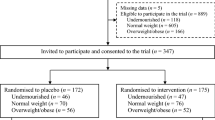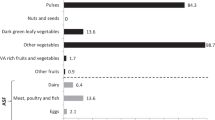Abstract
Objective:
To determine the effects of eating carotene-rich green and yellow vegetables on the prevalence of anaemia, iron deficiency and iron-deficiency anaemia in schoolchildren.
Subjects and methods:
Schoolchildren (n=104), aged 9–12 years, received standardized meals containing 4.2 mg of provitamin A carotenoids/day (mainly β-carotene) from yellow and green leafy vegetables and at least 7 g dietary fat/day. The meals were provided three times/day, 5 days/week, for 9 weeks at school. Before and after the dietary intervention, total-body vitamin A pool size was assessed by using the deuterated-retinol-dilution method; serum retinol and β-carotene concentrations were measured by high-performance liquid chromatography; and whole blood haemoglobin (Hb) and zinc protoporphyrin (ZnPP) concentrations were measured by using a photometer and a hematofluorometer, respectively.
Results:
After 9 weeks, the mean total-body vitamin A pool size increased twofold (95% confidence interval (CI): −0.11, −0.07 μmol retinol; P<0.001), and serum β-carotene concentration increased fivefold (95% CI: −0.97, −0.79 μmol/l; P<0.001). Blood Hb (95% CI: −1.02, −0.52 g per 100 ml; P<0.001) and ZnPP increased (95% CI: −11.82, −4.57 μmol/mol haem; P<0.001). The prevalence of anaemia (Hb<11.5 g per 100 ml) decreased from 12.5 to 1.9% (P<0.001). There were no significant changes in the prevalence of iron deficiency or iron-deficiency anaemia.
Conclusions:
Ingestion of carotene-rich yellow and green leafy vegetables improves the total-body vitamin A pool size and Hb concentration, and decreases anaemia rates in Filipino schoolchildren, with no effect on iron deficiency or iron-deficiency anaemia rates.
This is a preview of subscription content, access via your institution
Access options
Subscribe to this journal
Receive 12 print issues and online access
$259.00 per year
only $21.58 per issue
Buy this article
- Purchase on Springer Link
- Instant access to full article PDF
Prices may be subject to local taxes which are calculated during checkout
Similar content being viewed by others
References
Agte V, Jahagirdar M, Chiplonkar S (2006). GLV supplements increased plasma beta-carotene, vitamin C, zinc and hemoglobin in young healthy adults. Eur J Nutr 45, 29–36.
Bloem MW, Wedel M, Egger RJ, Speek AJ, Schrijver J, Saowakontha S et al. (1989). Iron metabolism and vitamin A deficiency in children in Northeast Thailand. Am J Clin Nutr 50, 332–338.
Bloem MW, Wedel M, van Agtmaal EJ, Speek AJ, Saowakontha S, Schreurs WHP (1990). Vitamin A intervention: short-term effects of a single, oral, massive dose on iron metabolism. Am J Clin Nutr 51, 76–79.
Cabalda AB, Tengco LW, Solon JAA, Sarol JN, Solon PR, Solon FS (2009). Efficacy of pandesal baked from wheat flour fortified with iron and vitamin A in improving the iron and anthropometric status of anemic schoolchildren in the Philippines. J Am Coll Nutr (in press).
de Pee S, West CE, Permaesih D, Martuti S, Muhilal, Hautvast JG (1998). Orange fruit is more effective than are dark-green, leafy vegetables in increasing serum concentrations of retinol and β-carotene in schoolchildren in Indonesia. Am J Clin Nutr 68, 1058–1067.
Doherty CP (2007). Host-pathogen interactions: the role of iron. J Nutr 137, 1341–1344.
Food and Nutrition Research Institute (1997). The Philippines Food Composition Tables. Food and Nutrition Research Institute –Department of Science and Technology: Taguig City, Philippines.
Food and Nutrition Research Institute (2002). Recommended Energy and Nutrient Intakes Philippines, 2002 ed. Food and Nutrition Research Institute –Department of Science and Technology: Taguig City, Philippines.
Food and Nutrition Research Institute (2006). Philippine Nutrition Facts and Figures 2003. Food and Nutrition Research Institute –Department of Science and Technology: Taguig City.
Garcia-Casal MN, Layrisse M, Solano L, Baron MA, Arguello F, Llovera D et al. (1998). Vitamin A and beta-carotene can improve non-heme iron absorption from rice, wheat and corn by humans. J Nutr 128, 646–650.
Garcia-Casal MN, Leets I, Layrisse M (2000). Beta-carotene and inhibitors of iron absorption modify iron uptake by Caco-2 cells. J Nutr 130, 5–9.
Kabyemela ER, Fried M, Kurtis JD, Mutabingwa TK, Duffy PE (2008). Decreased susceptibility to Plasmodium falciparum infection in pregnant women with iron deficiency. J Infect Dis 198, 163–166.
Kolsteren P, Rahman SR, Hilderbrand K, Diniz A (1999). Treatment for iron deficiency anaemia with a combined supplementation of iron, vitamin A and zinc in women of Dinajpur, Bangladesh. Eur J Clin Nutr 53, 102–106.
Kuczmarski RJ, Ogden CL, Grummer-Strawn LM, Flegal KM, Guo SS, Wei R et al. (2000). CDC Growth Charts: United States. Advance Data from Vital and Health Statistics; No. 314. National Center for Health Statistics: Hyattsville, Maryland.
Martin LK, Beaver P (1968). Evaluation of Kato's thick smear technique for quantitiative diagnosis of helminth infections. Am J Trop Med Hyg 17, 389–391.
McLean E, Egli I, Cogswell M, de Benoist B, Wojdyla D (2007). Worldwide prevalence of anemia in preschool aged children, pregnant women and non-pregnant women of reproductive age. In: Klaus K, Zimmermann MB (eds). Nutritional Anemia. Sight and Life Press: Switzerland.
Mejia LA, Arroyave G (1982). The effect of vitamin A fortification of sugar on iron metabolism in preschool children in Guatemala. Am J Clin Nutr 36, 87–93.
Mejia LA, Chew F (1988). Hematological effect of supplementing anemic children with vitamin A alone and in combination with iron. Am J Clin Nutr 48, 595–600.
Muhilal, Permeish D, Idjradinata YR, Muherdiyantiningsih, Karyadi D (1988). Vitamin A-fortified monosodium glutamate and health, growth and survival of children: a controlled trial. Am J Clin Nutr 48, 1271–1276.
Muslimatum S, Schmidt MK, Schultink W, West CE, Hautvast JGAJ, Gross R et al. (2001). Weekly supplementation with iron and vitamin A during pregnancy increases hemoglobin concentration but decreases serum ferritin concentration in Indonesian pregnant women. J Nutr 131, 85–90.
Mwanri L, Worsley A, Ryan P, Masika J (2000). Supplemental vitamin A improves anemia and growth in anemic school children in Tanzania. J Nutr 130, 2691–2696.
Ncube TN, Greiner T, Malaba LC, Gebre-Medhin M (2001). Supplementing lactating women with pureed papaya and grated carrots improved vitamin A status in a placebo-controlled trial. J Nutr 131, 1497–1502.
Olsen A, Magnussen P, Ouma JH, Andreassen J, Friis H (1998). The contribution of hookworm and other parasitic infections to hemoglobin and iron status among children and adults in western Kenya. Trans R Soc Trop Med Hyg 92, 643–649.
Panth M, Shatrunga V, Yasoddhara P, Sivakumar B (1990). Effect of vitamin A supplementation on hemoglobin and vitamin A levels during pregnancy. Br J Nutr 64, 351–358.
Ribaya-Mercado JD, Maramag CC, Tengco LW, Blumberg JB, Solon FS (2008). Relationships of body mass index with serum carotenoids, tocopherols and retinol at steady-state and in response to a carotenoid-rich vegetable diet intervention in Filipino schoolchildren. Biosci Rep 28, 97–106.
Ribaya-Mercado JD, Maramag CC, Tengco LW, Dolnikowski GG, Blumberg JB, Solon FS (2007). Carotene-rich plant foods ingested with minimal dietary fat enhance the total-body vitamin A pool size in Filipino schoolchildren as assessed by stable-isotope-dilution methodology. Am J Clin Nutr 85, 1041–1049.
Risonar MG, Tengco LW, Rayco-Solon P, Solon FS (2008a). The effect of a school-based weekly iron supplementation delivery system among anemic schoolchildren in the Philippines. Eur J Clin Nutr 62, 991–996.
Risonar MGD, Rayco-Solon P, Tengco LW, Sarol JN, Paulino LS, Solon FS (2008b). Effectiveness of a redesigned iron supplementation delivery system for pregnant women in Negros Occidental, Philippines. Public Health Nutr 27, 1–9.
Roodenburg AJC, West CE, Hovenier R, Beynen AC (1996). Supplemental vitamin A enhances the recovery from iron deficiency in rats with chronic vitamin A deficiency. Br J Nutr 75, 623–636.
Sazawal S, Black RE, Ramsan M, Chwaya HM, Stoltzfus RJ, Dutta A et al. (2006). Effects of routine prophylactic supplementation with iron and folic acid on admission to hospital and mortality in preschool children in a high malaria transmission setting: community-based, randomised, placebo-controlled trial. Lancet 367, 133–143.
Schultink W, Gross R, Gliwitzki M, Karyadi D, Matulessi P (1995). Effect of daily vs twice weekly iron supplementation in Indonesian preschool children with low iron status. Am J Clin Nutr 61, 111–115.
Semba RD, Bloem MW (2002). The anemia of vitamin A deficiency: epidemiology and pathogenesis. Eur J Clin Nutr 56, 271–281.
Smith JC, Makdani D, Hegar A, Rao D, Douglass LW (1999). Vitamin A and zinc supplementation of preschool children. J Am Coll Nutr 18, 213–222.
Solon FS, Sarol Jr JN, Bernardo AB, Solon JA, Mehansho H, Sanchez-Fermin LE et al. (2003). Effect of a multiple-micronutrient-fortified fruit powder beverage on the nutrition status, physical fitness, and cognitive performance of schoolchildren in the Philippines. Food Nutr Bull 24 (Suppl), S129–S140.
Stephensen CB, Gildengorin G (2000). Serum retinol, the acute phase response, and the apparent misclassification of vitamin A status in the third National Health and Nutrition Examination Survey. Am J Clin Nutr 72, 1170–1178.
Suharno D, West CE, Muhilal, Karyadi D, Hautvast JG (1993). Supplementation with vitamin A and iron for nutritional anemia in pregnant women in West Java, Indonesia. Lancet 342, 1325–1328.
Takyi EEK (1999). Children's consumption of dark green, leafy vegetables with added fat enhances serum retinol. Am J Clin Nutr 129, 1549–1554.
Tengco LW, Rayco-Solon P, Solon JA, Sarol Jr JN, Solon FS (2008). Determinants of anemia among preschool children in the Philippines. J Am Coll Nutr 27, 229–243.
United Nations Administrative Committee on Coordination/Sub-Committee on Nutrition (2000). Fourth Report on the World Nutrition Situation. ACC/SCN/IFPRI: Washington, DC.
United Nations Children's Fund/United Nations University/World Health Organization (2001). Iron Deficiency Anemia: Assessment, Prevention and Control. A Guide for Programme Managers. WHO/NHD/01.3. WHO: Geneva.
Vuong LT, Dueker SR, Murphy SP (2002). Plasma β-carotene and retinol concentrations of children increase after a 30-d supplementation with the fruit Momordica cochinchinensis (gac). Am J Clin Nutr 75, 872–879.
Zimmermann MB, Biebinger R, Rohner F, Dib A, Zeder C, Hurrell RF et al. (2006). Vitamin A supplementation in children with poor vitamin A and iron status increases erythropoietin and concentrations without changing total body iron. Am J Clin Nutr 84, 580–586.
Acknowledgements
We thank the children who participated in this study and their caregivers; and the staff of the Nutrition Center of the Philippines, and of the Bureau of Research and Laboratories, Department of Health, Manila, for their contributions during the field work.
Author information
Authors and Affiliations
Corresponding author
Ethics declarations
Competing interests
The authors declare no conflict of interest.
Additional information
Contributors: CCM coordinated the implementation of the study, participated in data analysis and writing of the manuscript; JDR-M was principal investigator, participated in the study design and writing of the manuscript; PR-S contributed to data analysis and writing of the manuscript; JAAS contributed to the writing of the manuscript; LWT coordinated the implementation of the study; JBB coordinated the procedure at Tufts University; FSS participated in the study design and was overall coordinator of procedures in the Philippines. The authors critically reviewed the manuscript.
Rights and permissions
About this article
Cite this article
Maramag, C., Ribaya-Mercado, J., Rayco-Solon, P. et al. Influence of carotene-rich vegetable meals on the prevalence of anaemia and iron deficiency in Filipino schoolchildren. Eur J Clin Nutr 64, 468–474 (2010). https://doi.org/10.1038/ejcn.2010.23
Received:
Revised:
Accepted:
Published:
Issue Date:
DOI: https://doi.org/10.1038/ejcn.2010.23
Keywords
This article is cited by
-
Supplementation of red palm olein-enriched biscuits improves levels of provitamin A carotenes, iron, and erythropoiesis in vitamin A-deficient primary schoolchildren: a double-blinded randomised controlled trial
European Journal of Nutrition (2024)
-
Poor nutritional status of schoolchildren in urban and peri-urban areas of Ouagadougou (Burkina Faso)
Nutrition Journal (2011)



